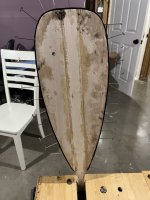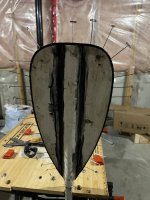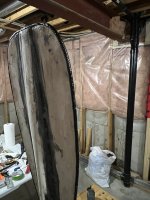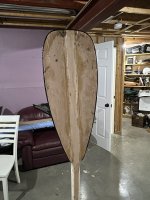-
Happy Boxing Day! 🎁📦💰
You are using an out of date browser. It may not display this or other websites correctly.
You should upgrade or use an alternative browser.
You should upgrade or use an alternative browser.
Bent Shaft Paddles
- Thread starter stripperguy
- Start date
Well, all the phenolic tips are epoxied on and rough trimmed.

You can also see where I've added epoxy fillets at the shaft/blade interface. If there were no fillet there, I would never get the glass to tuck into those corners.
Couple decisions now...what weight cloth, and what to do about the edges?
My previous paddle builds used 4 oz E glass, but Cruiser mentioned 2 oz cloth. Hmmm, let's table that discussion for a few moments.
Edge treatment? I'm considering some edge wrap when I laminate the blades, to avoid this sort of condition:

That's one of my 25 year old paddles, see how the edge of the cedar is worn away, but not the phenolic tip?
So I was curious if my similar aged Sawyer paddles (I don't care if they used to have a Mad River label on them, they're Sawyers, which in reality are Al Camp's) had the same sort of wear.
Take a look:
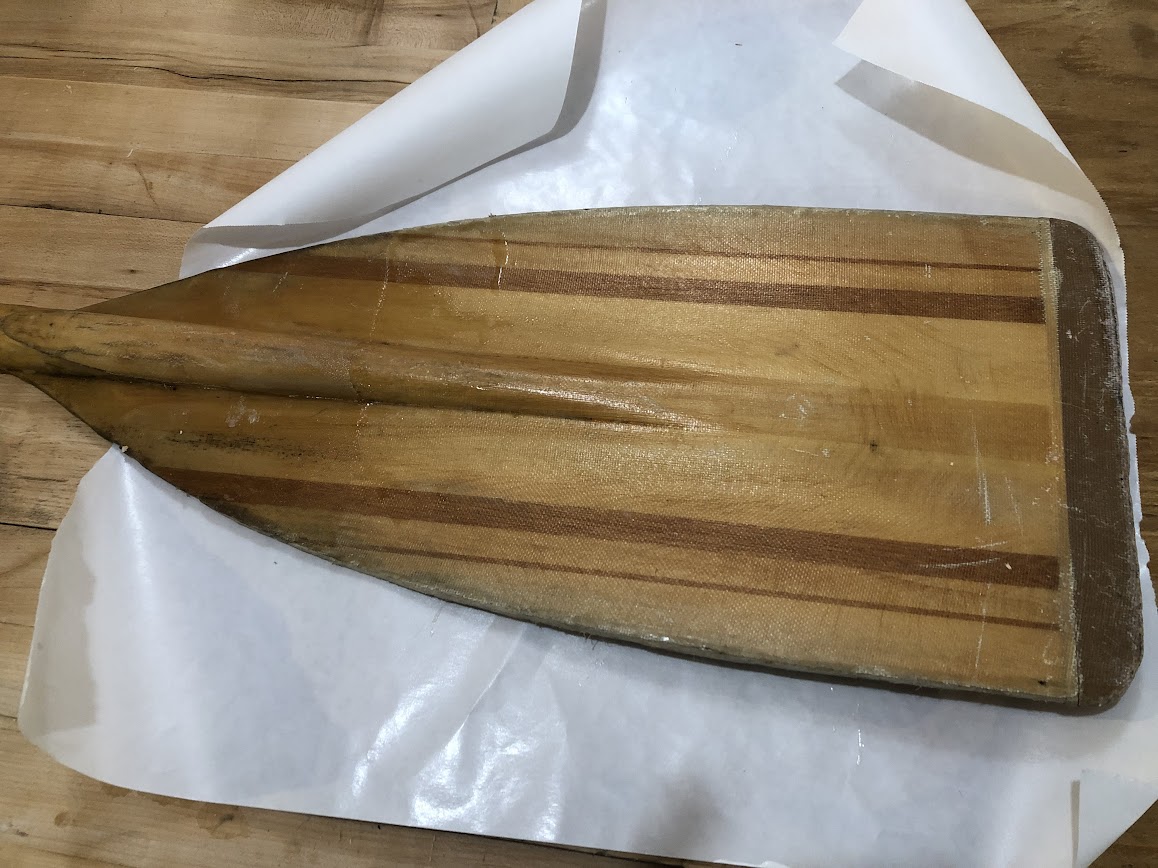
You can see a few things going on here. Firstly, you see where the shaft had delaminated and I repaired it maybe 20 years ago. But little edge wear.
But let's look a little closer:
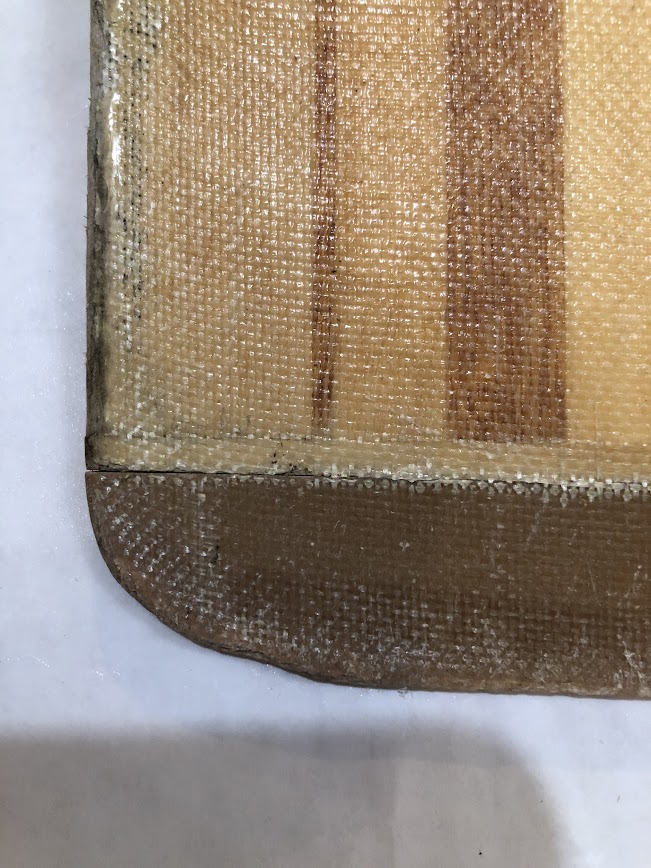
Yup, those tips are ready to fail all the way across. I don't know the details of this paddle's construction, but there appears to be some sort of filler applied at the tip/blade interface. The glass has fatigued on both sides and at both edges. What adhesive and/or filler was used, I have no idea. However, if the laminate was strong enough, that joint should never see that much stress.
So,I'll circle back to that tabled discussion about the 2 oz vs 4 oz cloth...4 oz it is. Even though I'm confident that my tip/blade joint is superior to the commercially built paddle, I am a belt, suspenders and rope kind of guy.
That leaves only a decision about edge treatment. On one hand, my paddles have lasted 25 and 35 years with exposed end grain (they were epoxy sealed at some point in their life). OTOH, I've seen someones paddle (Alan's maybe? Cruiser's) with a very clean wrap on the edges. A contrasting color, was it black? Some Dynel would be nice, I think Mr McCrea was diddling with Dynel sleeving. I'm not confident that I could reliable slit some Dynel sleeving...Maybe a bias woven tape? I mean, even glass would be better than raw cedar end grain.
You can also see where I've added epoxy fillets at the shaft/blade interface. If there were no fillet there, I would never get the glass to tuck into those corners.
Couple decisions now...what weight cloth, and what to do about the edges?
My previous paddle builds used 4 oz E glass, but Cruiser mentioned 2 oz cloth. Hmmm, let's table that discussion for a few moments.
Edge treatment? I'm considering some edge wrap when I laminate the blades, to avoid this sort of condition:
That's one of my 25 year old paddles, see how the edge of the cedar is worn away, but not the phenolic tip?
So I was curious if my similar aged Sawyer paddles (I don't care if they used to have a Mad River label on them, they're Sawyers, which in reality are Al Camp's) had the same sort of wear.
Take a look:
You can see a few things going on here. Firstly, you see where the shaft had delaminated and I repaired it maybe 20 years ago. But little edge wear.
But let's look a little closer:
Yup, those tips are ready to fail all the way across. I don't know the details of this paddle's construction, but there appears to be some sort of filler applied at the tip/blade interface. The glass has fatigued on both sides and at both edges. What adhesive and/or filler was used, I have no idea. However, if the laminate was strong enough, that joint should never see that much stress.
So,I'll circle back to that tabled discussion about the 2 oz vs 4 oz cloth...4 oz it is. Even though I'm confident that my tip/blade joint is superior to the commercially built paddle, I am a belt, suspenders and rope kind of guy.
That leaves only a decision about edge treatment. On one hand, my paddles have lasted 25 and 35 years with exposed end grain (they were epoxy sealed at some point in their life). OTOH, I've seen someones paddle (Alan's maybe? Cruiser's) with a very clean wrap on the edges. A contrasting color, was it black? Some Dynel would be nice, I think Mr McCrea was diddling with Dynel sleeving. I'm not confident that I could reliable slit some Dynel sleeving...Maybe a bias woven tape? I mean, even glass would be better than raw cedar end grain.
- Joined
- Jul 6, 2021
- Messages
- 643
- Reaction score
- 1,174
None of the cord materials I have seen would wrap a fine enough edge, might as well just epoxy some car door edging on the blade and call it kerpluny.
I have wrapped a bunch of blade edges using carbon fiber tow. The tow I use is less than ¼” wide and composed of something like 20,000 individual strands of carbon thread. With some epoxy, I use G/flex, it will wrap around even a fine blade edge
https://www.canoetripping.net/threads/paddle-work-in-progress.20631/#post-20634
I try not to smash my paddle blades, not always successfully, and the carbon tow and G/flex has held up well.
I have wrapped a bunch of blade edges using carbon fiber tow. The tow I use is less than ¼” wide and composed of something like 20,000 individual strands of carbon thread. With some epoxy, I use G/flex, it will wrap around even a fine blade edge
https://www.canoetripping.net/threads/paddle-work-in-progress.20631/#post-20634
I try not to smash my paddle blades, not always successfully, and the carbon tow and G/flex has held up well.
Are you going to leave the corners of your blades that squarish or round them off a bit?
- Joined
- Jul 6, 2021
- Messages
- 643
- Reaction score
- 1,174
A couple photos of paddles with carbon fiber tow edging
Old Kobers with tow edging being installed just at the ends of the blade.
 P5110018 by Mike McCrea, on Flickr
P5110018 by Mike McCrea, on Flickr
Hard to see but there cherry paddles have had carbon tow wraps around the full length of the blades. A little dinged but holding up well.
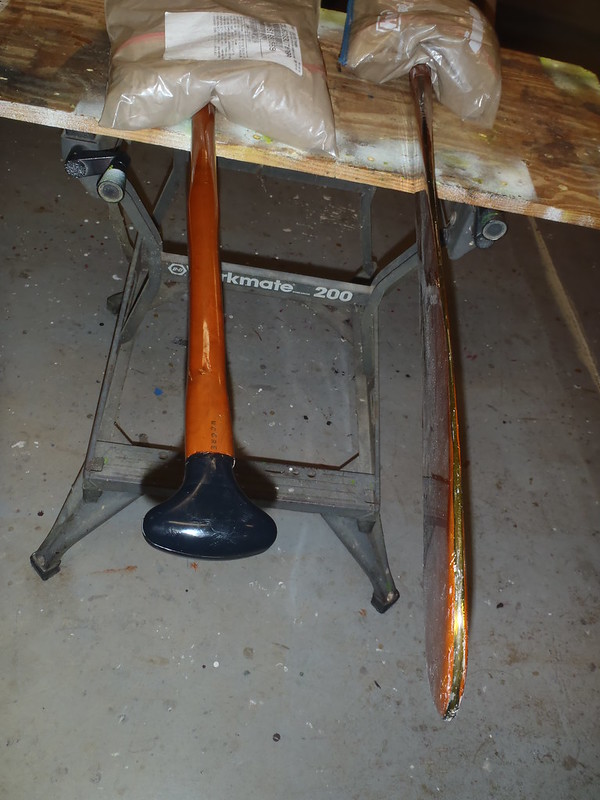 P6160013 by Mike McCrea, on Flickr
P6160013 by Mike McCrea, on Flickr
Of course that carbon fiber tow is most helpful if wrapping around a curve.
Old Kobers with tow edging being installed just at the ends of the blade.
 P5110018 by Mike McCrea, on Flickr
P5110018 by Mike McCrea, on FlickrHard to see but there cherry paddles have had carbon tow wraps around the full length of the blades. A little dinged but holding up well.
 P6160013 by Mike McCrea, on Flickr
P6160013 by Mike McCrea, on FlickrOf course that carbon fiber tow is most helpful if wrapping around a curve.
Glenn,
Do you mean like this?

After I glass the blades, I'll shape that radius a bit more, but it's close to final profile now...
Mr. McCrea, car door edging is an option! The final thickness of the blades will be a little less than 1/8", with the edges getting a full radius. Some finer cloths can wrap a 1/16" radius, but maybe not that Dynel sleeving. Probably overkill anyway, since those raw edges have survives so long as they are.
Any form of graphite is a non starter for me, knowing its abrasion resistance...or lack thereof.
And Clint,
I haven't forgotten your comment/query. I think I'll model a hollow shaft and see what the strength/weight advantage is relative to a solid shaft. Could be a nice option, I would be concerned with the balance of such a paddle though, the blades may end up far heavier than the shafts and could make for an odd feel.
Do you mean like this?
After I glass the blades, I'll shape that radius a bit more, but it's close to final profile now...
Mr. McCrea, car door edging is an option! The final thickness of the blades will be a little less than 1/8", with the edges getting a full radius. Some finer cloths can wrap a 1/16" radius, but maybe not that Dynel sleeving. Probably overkill anyway, since those raw edges have survives so long as they are.
Any form of graphite is a non starter for me, knowing its abrasion resistance...or lack thereof.
And Clint,
I haven't forgotten your comment/query. I think I'll model a hollow shaft and see what the strength/weight advantage is relative to a solid shaft. Could be a nice option, I would be concerned with the balance of such a paddle though, the blades may end up far heavier than the shafts and could make for an odd feel.
Prettty sneaky, Mike, adding to your post while I'm madly pecking away.
Yeah, that carbon tow looks very elegant, and seems to have held up well. Many of these paddles are not for my use, though, and some of the intended paddlers are not...uhmmm, cautious, careful, observant?
Yeah, that carbon tow looks very elegant, and seems to have held up well. Many of these paddles are not for my use, though, and some of the intended paddlers are not...uhmmm, cautious, careful, observant?
Not a new idea, but I‘m using epoxy saturated Kevlar cord to edge the paddles I am building now (balsa paddles under carbon fibre, so wanted the edges to be very well protected all around) - the edges are about 5/32. Got the cord on Amazon and thinner sizes are available if you are going down to 1/8. It seems plenty strong, although not quite as tidy as Mike’s carbon tow. It also added about 0.5 ounces to the paddle‘s weight, if that’s a consideration.
Ran out of carbon fibre sleeve for the paddle shafts so it’s all on hold for a few weeks while I wait for Soller Composites to come through.
Ran out of carbon fibre sleeve for the paddle shafts so it’s all on hold for a few weeks while I wait for Soller Composites to come through.
Attachments
Last edited:
If I was going to do an edge treatment all the way up, this would be near the top of my list for consideration ... it is from Nick Sdade and is a very approachable method IMO
Brian
Brian
Thanks, gentlemen, I like both of those techniques.
I suppose I better get looking for a suitable material for the edges.
A non woven kevlar tow could work nicely, or some other aramid tow, or any other high abrasion resistant material. Heck, it doesn’t even need to be highly abrasion resistant, almost anything but graphite will do.
As I type, I’m fighting the urge to deconstruct a bunch of Dynel cloth…
I suppose I better get looking for a suitable material for the edges.
A non woven kevlar tow could work nicely, or some other aramid tow, or any other high abrasion resistant material. Heck, it doesn’t even need to be highly abrasion resistant, almost anything but graphite will do.
As I type, I’m fighting the urge to deconstruct a bunch of Dynel cloth…
- Joined
- Jul 6, 2021
- Messages
- 643
- Reaction score
- 1,174
Dyneema or Spectra cord perhaps? Maybe Zing-it if you were to incise that groove.
The carbon fiber tow has held up surprisingly well, which may be more attributable to the G/flex below and bead of G/flex atop the tow.
The carbon fiber tow has held up surprisingly well, which may be more attributable to the G/flex below and bead of G/flex atop the tow.
I would like to understand what all the edging is for on the blades? I am assuming it is to toughen them up.
Is this to make a blade to last 500 miles?
Or 10,000 miles?
Where ya'll's location of paddling it is really shallow and rocky?
Or is it to keep the edge nicks water infiltration getting to the wood?
Only for wood blades, not for composite blades?
Just curious, learning.
Yea that may make feel a little off. Could counter with the handle but that may negate any weight savings. Hit and switch paddling may not notice it as much with the hand close to the blade.
Is this to make a blade to last 500 miles?
Or 10,000 miles?
Where ya'll's location of paddling it is really shallow and rocky?
Or is it to keep the edge nicks water infiltration getting to the wood?
Only for wood blades, not for composite blades?
Just curious, learning.
And Clint,
I haven't forgotten your comment/query. I think I'll model a hollow shaft and see what the strength/weight advantage is relative to a solid shaft. Could be a nice option, I would be concerned with the balance of such a paddle though, the blades may end up far heavier than the shafts and could make for an odd feel.
Yea that may make feel a little off. Could counter with the handle but that may negate any weight savings. Hit and switch paddling may not notice it as much with the hand close to the blade.
Clint,
I put the phenolic tips on the blades to protect from rock bashes and years and years of beach landings, the tips have survived 35 and 25 years in rugged ADK outings. The paddles need to outlive me, in the hands of others that will likely be even more rude to the paddles than I have been.
The edge treatments would be to protect from wear when the blade is dragged/rubbed against the hull. Over time, this does lead to water intrusion and ultimately delamination as the wood core degrades.
As far as full composite paddles, that’s not quite what I’m looking for, these paddles have a total cost to build this far of about $10 each. But beyond the cost, I prefer the esthetics and require a slight lack of stiffness in the shaft. In past decades, I had suffered badly from tendinitis and the more forgiving shafts mitigated paddling as a source of irritation. Currently my muscles have lost strength, so I don’t have such a tendency to overpower my tendons and ligaments, but the next generations of paddlers may suffer the same fate, hence the wood shafts.
BTW, for anyone else that’s watching, don’t discount the abrasive effects of using a paddle for balance or landing/launching. Even on a soft sand beach, using your paddle for support is the equivalent of attacking the paddle tip with 40 grit abrasive, a situation exasperated by the lack of surface area on our finely tapered blade tips.
Or maybe It’s not all that bad and my viewpoints are jaded and skewed by spending too much of my life immersed in tribology…
I put the phenolic tips on the blades to protect from rock bashes and years and years of beach landings, the tips have survived 35 and 25 years in rugged ADK outings. The paddles need to outlive me, in the hands of others that will likely be even more rude to the paddles than I have been.
The edge treatments would be to protect from wear when the blade is dragged/rubbed against the hull. Over time, this does lead to water intrusion and ultimately delamination as the wood core degrades.
As far as full composite paddles, that’s not quite what I’m looking for, these paddles have a total cost to build this far of about $10 each. But beyond the cost, I prefer the esthetics and require a slight lack of stiffness in the shaft. In past decades, I had suffered badly from tendinitis and the more forgiving shafts mitigated paddling as a source of irritation. Currently my muscles have lost strength, so I don’t have such a tendency to overpower my tendons and ligaments, but the next generations of paddlers may suffer the same fate, hence the wood shafts.
BTW, for anyone else that’s watching, don’t discount the abrasive effects of using a paddle for balance or landing/launching. Even on a soft sand beach, using your paddle for support is the equivalent of attacking the paddle tip with 40 grit abrasive, a situation exasperated by the lack of surface area on our finely tapered blade tips.
Or maybe It’s not all that bad and my viewpoints are jaded and skewed by spending too much of my life immersed in tribology…
I gotta ask.....where did you get the phenolic tip, and how do I get some?
- Joined
- Jul 6, 2021
- Messages
- 643
- Reaction score
- 1,174
About the abrasive effects of using a paddle, especially the finely tapered blade of a wood paddle, for landing/launching (and getting out) balance, on cobble bars or sandy bottoms or worse, it does take a toll on my paddle blades. Better to pay that repairable/replaceable price than go in for maintenance on my knees or other aged body parts.
I bring at least two paddles, and in an anticipated abusive environment, the “back up” is typically more durable, or sometimes more sacrificial. But I’ll still take some protection on the blade ends. Unlike Stripperguy I lack the skills to whip up a bunch of DIY wood paddles. Like Stripper guy, with the exception of a few no-you-may-not-borrow carbon paddles, mine may be used and abused by family members and friends, with sad tales of woe to show.
Or I just grab the 5’ long closet rod push pole and go nuts.
I bring at least two paddles, and in an anticipated abusive environment, the “back up” is typically more durable, or sometimes more sacrificial. But I’ll still take some protection on the blade ends. Unlike Stripperguy I lack the skills to whip up a bunch of DIY wood paddles. Like Stripper guy, with the exception of a few no-you-may-not-borrow carbon paddles, mine may be used and abused by family members and friends, with sad tales of woe to show.
Or I just grab the 5’ long closet rod push pole and go nuts.
Mem,I gotta ask.....where did you get the phenolic tip, and how do I get some?
I bought a 12" x 12" x 1/8" thick piece of linen reinforced phenolic from Amazon...something like $25
Here's a link, I think:
Amazon.com: USA Sealing XX Garolite Sheet - 1/8" Thick x 12" Wide x 12" Long : Industrial & Scientific
Amazon.com: USA Sealing XX Garolite Sheet - 1/8" Thick x 12" Wide x 12" Long : Industrial & Scientific
www.amazon.com
Thanks Stripperguy.....so how do you apply it? I've wondered about that kind of thing for a while, I usually use my paddles till they break and then burn them, then build another one. I've got a new one in the garage with one thin coat of epoxy on it.
I’ve been thinking about trying a paddle build for about a year now. Originally wanted to go with a solid one piece, and avoid the added weight of everything. But the more I look at the paddles you all have built and continue to make, it actually motivates me to try this route.
Very good looking paddles fellas! I saw basswood, or maybe balsa, some western red cedar. And maybe oak?? What wood is your favorite to use for paddles? Have you noticed flex in different species for the shaft or blade?
During my off season from work, I pick up shifts at a local wood shop. It’s fun, and also aggravating. We discard SOOOO much scrap wood it’s ridiculous! I’ve gathered several great pieces of black walnut, basswood, butternut, white cedar, cherry, from medium strips to paper veneer like. I think this will be a fun project to try during winter.
Very good looking paddles fellas! I saw basswood, or maybe balsa, some western red cedar. And maybe oak?? What wood is your favorite to use for paddles? Have you noticed flex in different species for the shaft or blade?
During my off season from work, I pick up shifts at a local wood shop. It’s fun, and also aggravating. We discard SOOOO much scrap wood it’s ridiculous! I’ve gathered several great pieces of black walnut, basswood, butternut, white cedar, cherry, from medium strips to paper veneer like. I think this will be a fun project to try during winter.
On the paddles that I built and the ones I bought, the glass goes over the wood blades and the phenolic tip.
On my paddles, I stick the tips on to the end grain of the cedar strips with the same epoxy I use for building strippers and thicken it with Cabosil. Not sure what was used on the bought paddles, but it did hold up for a couple decades at least.
On my paddles, I stick the tips on to the end grain of the cedar strips with the same epoxy I use for building strippers and thicken it with Cabosil. Not sure what was used on the bought paddles, but it did hold up for a couple decades at least.
Mr Red,
My paddles are only pine and western red cedar, nothing exotic, unless you count the phenolic tips.
As far as shaft flex, I don’t necessarily notice it, but my tendons do!!
And flex in the blades? Again, not enough to notice. The blades are glassed on both sides, so they end up quite stiff.
If you’re thinking about building some paddles, I say go for it. It’s a fun little project.
My paddles are only pine and western red cedar, nothing exotic, unless you count the phenolic tips.
As far as shaft flex, I don’t necessarily notice it, but my tendons do!!
And flex in the blades? Again, not enough to notice. The blades are glassed on both sides, so they end up quite stiff.
If you’re thinking about building some paddles, I say go for it. It’s a fun little project.
Similar threads
- Replies
- 5
- Views
- 1K
- Replies
- 4
- Views
- 725
- Replies
- 55
- Views
- 5K
- Replies
- 11
- Views
- 1K

